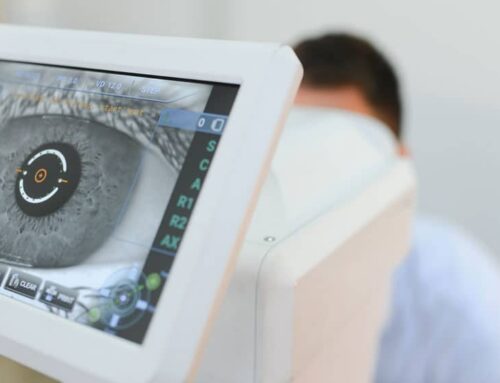Astigmatism is a common vision problem that affects millions of people, causing blurry or distorted vision. One of the most common questions eye doctors get asked is: “Can LASIK fix astigmatism?”
In this comprehensive guide, we’ll delve into the details of astigmatism, its different types, and how LASIK can fix it.
What is Astigmatism?
Astigmatism is a refractive error caused by an irregular curvature of the front part of the eye, specifically the cornea and lens. This irregularity prevents light from focusing properly on the retina, resulting in blurred or distorted vision. Unlike myopia (nearsightedness) or hyperopia (farsightedness), astigmatism affects vision at all distances.
Symptoms of Astigmatism
- Blurred or distorted vision
- Difficulty seeing at night
- Squinting
Are There Different Types of Astigmatism?
Astigmatism is not a one-size-fits-all condition. Understanding the different types can help in determining the appropriate treatment.
Regular Astigmatism
Regular astigmatism is the most common form and occurs when the cornea’s curvature is shaped like an American football. Imagine placing a football on the floor, and looking down over it. You would notice that part of the ball has a flatter curvature, and 90 degrees away the ball has a steeper curvature.
Regular astigmatism is usually easily corrected with LASIK, or other vision correction procedures, such as EVO ICL, PRK, or Custom Lens Replacement.
Irregular Astigmatism
Irregular astigmatism is less common and occurs when the cornea’s curvature is distorted. The curvature of the cornea can have all sorts of irregular peaks and valleys when looked at on a topographic map.
Irregular astigmatism can be caused by certain eye conditions or injuries to the eye. Examples of eye conditions that can cause irregular astigmatism are keratoconus, pellucid marginal degeneration, and anterior basement membrane dystrophy (ABMD).
This type is more challenging to correct with standard glasses or contact lenses and may require specialized treatments. Patients with irregular astigmatism may not be good candidates for LASIK or other laser vision correction procedures. In these cases, EVO ICL or Custom Lens Replacement may be better options.
How Does LASIK Work?
LASIK, or Laser-Assisted In Situ Keratomileusis, is a surgical procedure that reshapes the cornea to improve how light is focused on the retina. Here’s a step-by-step overview of the LASIK process:
- Preparation: The surgeon applies numbing drops to the eyes.
- Corneal Flap Creation: A thin flap is created in the cornea.
- Reshaping the Cornea: An excimer laser is used to reshape the underlying corneal tissue, correcting the refractive error, including astigmatism.
- Flap Repositioning: The corneal flap is repositioned and left to heal naturally without stitches.
The entire LASIK procedure takes about 15 minutes. For more details about how LASIK works read our main article here.
Can LASIK Fix Astigmatism?
Yes. LASIK can fix astigmatism. LASIK has fixed astigmatism for decades. Modern lasers are more accurate and precise at fixing astigmatism than ever. Let’s consider different types of patients with astigmatism:
Low-to-Moderate Regular Astigmatism
The majority of patients who have LASIK have astigmatism. Most patients have low to moderate amounts of regular astigmatism which are easily and routinely fixed every day.
Higher Regular Astigmatism
For high amounts of regular astigmatism, there are limits to how much different lasers can treat. Patient with over 4 diopters of astigmatism would be considered to be in this category.
Irregular Astigmatism
Irregular astigmatism can also be fixed with LASIK and other laser vision correction procedures. However, this is more advanced territory. “Topography guided LASIK” is a technique that can be performed to treat irregular astigmatism. However, some patients with irregular astigmatism may not be candidates.
Patient with irregular astigmatism should have a detailed and personalized conversation with their doctor about their vision correction options.
How Does LASIK Treat Astigmatism?
LASIK surgery addresses astigmatism by reshaping the cornea. The excimer laser used in LASIK is highly accurate and can remove microscopic amounts of corneal tissue to correct the curvature.
Steps in LASIK for Astigmatism
- Measure your prescription: Your doctor will perform a test called a “refraction” to emasure your prescription, including your astigmatism
- Mapping the Cornea: Detailed measurements of the cornea are taken to make sure you’re astigmatism is suitable for LASIK
- Laser Application: The excimer laser is programmed with the patient’s specific corneal measurements and is used to reshape the cornea, correcting the astigmatism.
- Post-Procedure Care: The corneal flap is repositioned, and the eye is allowed to heal, typically with minimal discomfort.
Who Should Not Have LASIK?
While LASIK is a popular and effective treatment, it’s not suitable for everyone. Certain conditions and factors can make LASIK a less viable option.
It’s important to know that there are other treatment options available for most patients who are not eligible for LASIK. These procedures include PRK, EVO ICL, and Custom Lens Replacement.
Unsuitable Candidates for LASIK
- Unstable Vision: Patients whose vision prescription has changed significantly in the past year.
- Thin Corneas: Patients with very thin corneas may not have enough tissue for the procedure.
- Severe Dry Eyes: Patients with severe chronic dry eye syndrome may experience worsened symptoms after LASIK, and should have their dry eye managed first.
- Eye Diseases: Conditions like keratoconus, glaucoma, cataracts, and others may make patients eligible for LASIK.
- Active autoimmune Disorders: Certain autoimmune diseases can affect the eye, and if active, LASIK should be avoided
- Pregnant or Nursing
Conclusion
LASIK surgery is a safe and highly effective treatment for correcting astigmatism, providing clear vision for millions of people worldwide. Always consult with a qualified ophthalmologist to determine if LASIK is the right choice for your specific condition.
If you’re struggling with astigmatism and considering LASIK, consult with an eye care professional to explore your options. With advancements in technology, LASIK continues to offer a promising solution for those seeking to improve their vision and quality of life.






